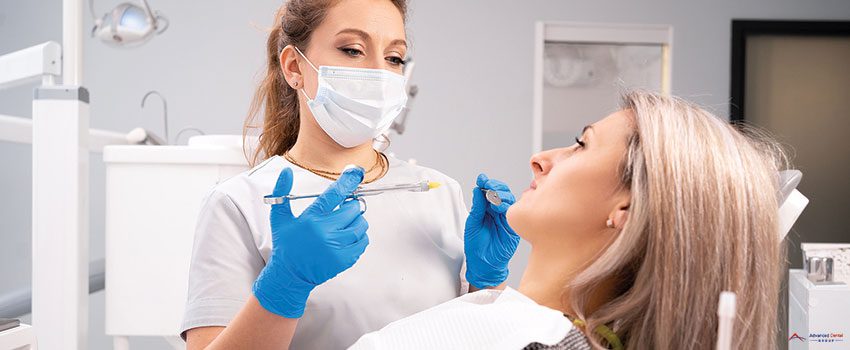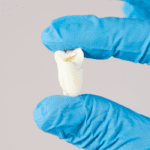No matter how diligent you try to maintain your oral health and hygiene, sometimes your dentist will recommend a dental extraction.
Many dental patients fear oral surgery. However, those who correctly approach the procedure will find that the experience is not as bad as they think it to be. If your dentist recommends that you have your tooth pulled, it usually means that usual dental interventions cannot save your tooth.
There is no need to feel anxious about having your teeth pulled; knowing how the procedure will go might help calm your fears. Advanced Dental Group is here to guide you on your first tooth extraction appointment.
What Is Dental Extraction?
Extraction is a procedure that involves removing a tooth entirely from its socket. It is sometimes called “pulling” a tooth. An oral surgeon or dentist can perform an extraction.
Tooth extraction is a fast outpatient procedure using intravenous, local, or general anesthesia. Removing visible teeth is simple; however, broken, below-the-surface, or impacted teeth require a more complex approach.
When Is a Tooth Extraction Procedure Necessary?
It is essential for health care providers to preserve natural teeth as much as possible. However, removing your tooth maybe necessary if it’s damaged beyond repair. Sometimes other options, such as fillings and crowns, are not sufficient.
Some of the instances where tooth extraction is necessary are:
Infection
Infection can occur when bacteria from the mouth enter the pulp. Dentists often treat this with root canal therapy (RCT) and antibiotics. Extraction is the last option if the infection is severe enough to render antibiotics and RCT ineffective.
Crowding
If your teeth are too large for your mouth, tooth extraction can help. Your dentist might recommend having one of your teeth pulled to allow your other teeth room to grow properly or shift to their correct place.
Risk of Infection
The risk of a tooth infection is sometimes enough to have it removed, especially if you are undergoing chemotherapy or a transplant — procedures that weaken your immune system.
What Are the Two Types of Tooth Removal?
The tooth removal method will depend on whether your tooth is visible or hidden. Here are the two types:
1. Simple
In a simple tooth extraction, dentists first administer a local anesthetic to numb the area around your tooth. Then, they use an elevator, an instrument that allows them to loosen the damaged tooth. Lastly, they use forceps to pull out the tooth. You won’t feel too much pain during the procedure.
2. Surgical
Your dentist will likely give you both intravenous and local anesthesia in surgical tooth extraction. Intravenous anesthesia makes you feel calm and relaxed. They may also administer general anesthesia, depending on your medical condition. You will be unconscious under general anesthesia.
An oral surgeon or general dentist will make a small incision to cut into your gum to remove your tooth. Sometimes, they may have to remove the bone around your tooth or trim it before extracting it.
How Much Does Tooth Extraction Cost?
The cost of tooth removal depends on the extent of tooth damage. A simple extraction typically costs between $75 to $200 per tooth. It may cost more or less depending on what type of anesthesia is required.
The cost of removing impacted teeth is much higher; it can run anywhere between $800 to $4,000. Your location can impact the cost of your procedure since dental services depend on your area’s living costs.
What Happens Before a Tooth Extraction Procedure?
Your dentist will assess the condition of your teeth and gums. Tell your dentist if you take any vitamins, medications, or supplements. They may also take x-rays to determine the extent of the damage.
After gathering all the information, your dentist will discuss your treatment options and sedation options.
What Happens After a Tooth Extraction?
Your dentist will place a piece of gauze at the extraction site once the procedure is done. Then, they will ask you to bite down with firm, steady pressure.
This will slow down bleeding and prevent blood clots from forming. Clotting is an integral part of healing, and it also lowers the risk of developing dry sockets. Once the bleeding has stopped, you can take the gauze off. Light bleeding may persist for the first 24 hours.
How Long is Tooth Extraction Healing Time?
A tooth extraction usually takes 1-2 weeks to heal. You will experience minimal discomfort, pain, and general unease during the recovery period. You will not be able to eat normally. You might experience some bleeding, but you can easily manage it with sterile gauzes or swabs. Your dentist will provide cleaning instructions for you to follow.
What to Do After Tooth Extraction?
These are some tips for quick recovery and care after tooth extraction:
1. Manage the pain.
The temporary numbness caused by the local anesthetic should last for a few hours after an extraction. Contact your dentist if the numbness does not go away. They might prescribe medication to relieve pain and inflammation following a procedure. However, patients can manage most routine extractions with over-the-counter medication like ibuprofen or acetaminophen.
2. Change dental gauzes.
After tooth extraction, the surgeon or dentist will apply a thick layer to the extraction site. The best way to control bleeding is to bite down on the gauze and apply consistent pressure.
The gauze must stay in place for about 20-30 minutes; remember to replace it when it gets soaked. After the surgery, bleeding is likely to continue for two days.
3. Avoid disturbing the extraction site.
The first 24 hours after an extraction is crucial. It can slow down the healing process by irritating or disturbing the affected area. It is essential to avoid the following:
- Smoking
- Using a straw
- Spitting
- Eating solid, crunchy foods
- Using mouthwash with alcohol content
- Drinking alcoholic beverages
- Touching the extraction site with your tongue
4. Control the swelling.
Some people may experience slight facial swelling around the extraction site; this is normal. A tip for care after a tooth extraction is to put ice on the face to reduce swelling.
5. Brush and floss properly.
After tooth removal, you can continue to floss and brush as usual. However, be mindful not to disrupt the blood clotting. You can also rinse with warm salt water every few hours for the first day following surgery. You can do this by adding half a teaspoon of salt and 1 cup of warm water.
6. Be careful when eating.
Drink plenty of fluids after tooth removal and eat soft, nutritious food.
Slowly reintroduce solid food when chewing is more comfortable. Your dentist may recommend that you chew on the opposite side of the extraction site until your wound is fully healed.
Call Advanced Dental Group
If you or someone you know needs emergency tooth removal, call Advanced Dental Group.
We can’t wait to serve you! We are connected to licensed dentists in St. Petersburg, FL. Stay on top of your dental health with us.





